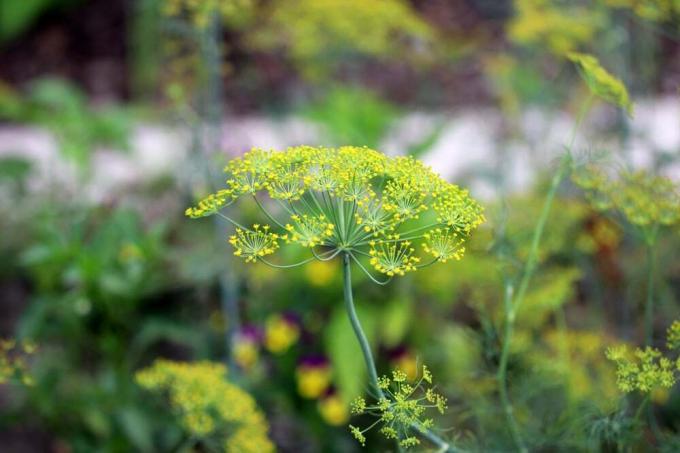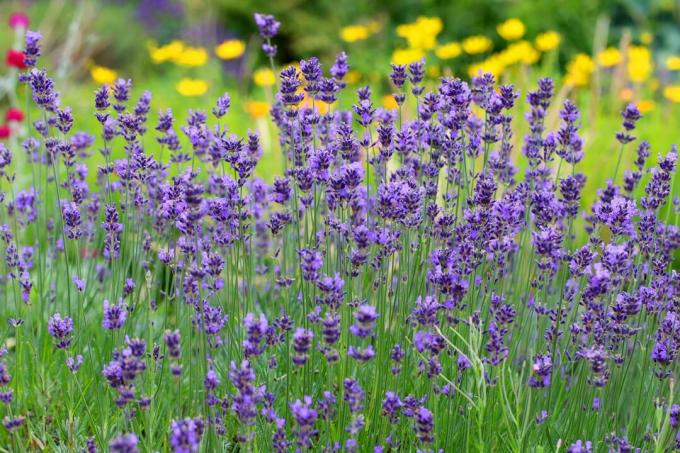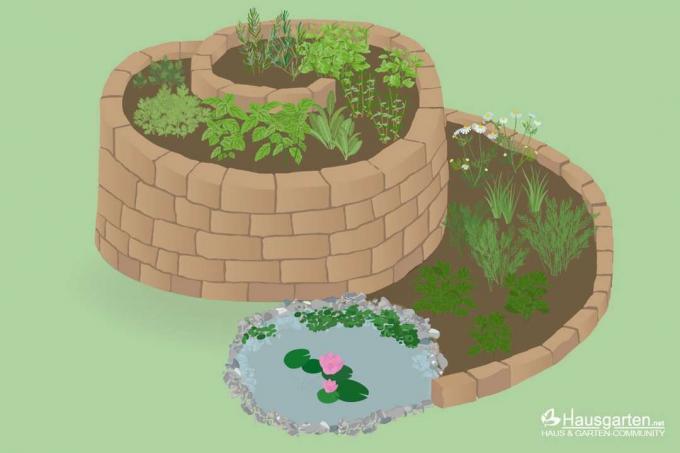

Table of contents
- Flowering dill edible?
- flowering is unavoidable
- Harvest and flowering time
- Increase dill leaf harvest
- flowers and seeds
Initially no more than an inconspicuous herbaceous plant, dill becomes a real beauty when it blooms and decorates the garden or balcony with summery colour. In many cases, flowers in kitchen herbs provide an extremely bitter taste. Some even become poisonous and can no longer be consumed. Is dill one of these garden herbs or is it edible despite flowering?
Flowering dill edible?
Many herbs become unpalatable for consumption once they begin flowering. This is not the case with dill (Anethum graveolens) and is therefore edible despite the flower. However, the flower still influences the herb:
- The aroma diminishes in the dill tips
- Blossoms make the herb drier (higher additional requirement to get tasteful flavor)
- Consistency becomes harder
- Flowering weakens the growth of the plant
flowering is unavoidable
So that dill thrives and forms a lot of essential oil, which is what creates the unique aroma arises, the plant needs a full sun location, so that many hours of sun fall on it. The disadvantage is that the sunlight also promotes flowering at the same time. If the Anethum graveolens were darker, the full aroma would have to be dispensed with. With full sun, a full aroma of dill can be expected for at least a few weeks - without full sun, you can do without it completely and the plant will not grow luxuriantly. That's why taking the flower is always the smart choice.
Harvest and flowering time

Dill is most aromatic when young, fresh shoots are harvested. The earliest harvest time is between six and eight weeks after sowing/germination. On the other hand, there is the flower, which usually appears in July and August. Since sowing outdoors is only recommended in May after the ice saints, there is not much time between the possible harvest date and flowering. If you only want to harvest the herb, you should start pre-cultivating indoors at the end of February/beginning of March.
After flowering
When the flowering period is over, the herb shoots draw "juice" again and the essential oil and aroma increase. It can usually be harvested by the end of September/beginning of October. Dill that is sown late may not flower until the fall. In this case, the harvest of aromatic shoot tips with the beginning of flowering is over, unless you are satisfied with less aromatic dill weed.
Increase dill leaf harvest
If dill is in full sun and in ideal soil conditions, it can grow enormously. If you want to harvest plenty of aromatic dill weed, sow it early and proceed as follows:
- Cut off the tops six weeks after germination
- Cut off whole branches from a branch length of 20 centimeters (promotes new growth)
- Use the harvested dill quickly (it loses its aroma when cut off)
Tip:
If there is no direct use for freshly harvested dill, it can also be frozen. In this way, it can be kept for at least a year without losing its aroma, which is the case with drying.
flowers and seeds
With the flower, however, further doors open for self-cultivators, because the flowers and the seeds they contain can also be used. The seeds contain aromatic substances that come very close to those of caraway and anise. Salads and sauces can be refined with it and tea can be prepared to treat digestive problems. The taste of the blossoms is clearly similar to that of dill tips. Suitable for decoration as well as seasoning. Especially on warm dishes, they unfold their aroma more intensively than the dill tips.
Tip:
As soon as the seeds turn brown, it is the ideal time to cut off the entire flower. You should not wait too long, otherwise the seeds will fall off, disappear into the ground or be eaten by animals in the garden.
 Home editorial office
Home editorial office
Learn more about growing herbs

Basil has black dots: what to do?
Especially basil bought in a pot from the supermarket tends to quickly develop black dots or spots on the leaves. This article explains why this is and what helps against it.

14 kitchen herbs that you can really keep in the kitchen
Sometimes a herb garden is only possible on the windowsill. If you don't have your own garden bed, for example, or in the months when the frost freezes the coveted greenery outside. Our list provides an overview of which herbs like the kitchen location permanently.

Parsley turns yellow: Four tips against yellow leaves
If the leaves of the parsley suddenly turn yellow, the so-called parsley disease is usually behind it. This can have many causes. If the outbreak of the disease is to be prevented, only prevention helps. More about this here.

You can combine lavender with these 13 plants
Whether you use it in the kitchen, want to enjoy its fragrance or its beauty, lavender is a must in any garden. Well combined, it can strengthen other plants or protect them from pests. We present the best plant neighbors.

8 tips for cutting and harvesting herbs properly
Fresh herbs from the garden should not be missing in any kitchen. They are versatile, exude pleasant and spicy scents and are a treat for the eye with their pretty flowers. In the kitchen, they can easily replace artificial flavor enhancers.

Herb spiral & herb snail: this is how it's done
A herb spiral or herb snail makes it possible to plant many different varieties in a particularly decorative way. However, this is not the only advantage of these variants of the culture. You can find out how to create them here.



